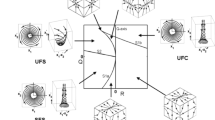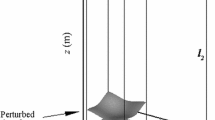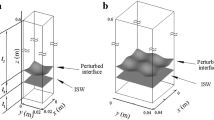Abstract
The interactions of a spherical flame with an incident shock wave and its reflected shock wave in a confined space were investigated using the three-dimensional reactive Navier-Stokes equations, with emphasis placed on the effect of chemical reactivity of mixture on the flame distortion and detonation initiation after the passage of the reflected shock wave. It is shown that the spatio-temporal characteristics of detonation initiation depend highly on the chemical reactivity of the mixture. When the chemical reactivity enhances, the flame can be severely distorted to form a reactive shock bifurcation structure with detonations initiating at different three-dimensional spatial locations. Moreover, the detonation initiation would occur earlier in a mixture of more enhanced reactivity. The results reveal that the detonations arise from hot spots in the unburned region which are initiated by the shock-detonation-transition mechanism.
Similar content being viewed by others
References
Khokhlov, A.M., Oran, E.S., Thomas, G. O.: Numerical simulation of deflagration-to-detonation transition: The role of shock-flame interactions in turbulent flame. Combustion and Flame 117, 323–339 (1999)
Khokhlov, A.M., Oran, E.S.: Numerical simulation of detonation initiation in a flame brush: The role of hot spots. Combustion and Flame 119, 400–416 (1999)
Dong, G., Fan, B.C., Ye, J.F.: Numerical investigation of ethylene flame bubble instability induced by shock waves. Shock Waves 17, 409–419 (2008)
Gui, M.Y., Fan, B.C., Dong, G., et al.: Experimental and numerical studies on interactions of a spherical flame with incident and reflected shocks. Acta Mechanica Sinica 25, 173–179 (2009)
Yang, J., Kubota, T., Zukoski, E.E.: Applications of shockinduced mixing to supersonic combustion. AIAA Journal 31, 854–862 (1993)
Oran, E.S., Gamezo, V.N.: Origins of the deflagration-to-detonation transition in gas-phrase combustion. Combustion and Flame 148, 4–47 (2007)
Gamezo, V.N., Khokhlov, A.M., Oran, E.S.: The influence of shock bifurcations on shock-flame interactions and DDT. Combustion and Flame 126, 1810–1826 (2001)
Thomas, G.O., Bambrey, R., Brown, C.: Experimental observations of flame acceleration and transition to detonation following shock-flame interaction. Combustion Theory and Modelling 5, 573–594 (2001)
Chakravarthy, S.R., Osher, S.: A new class of high accuracy TVD schemes for hyperbolic conservation laws. AIAA Paper 1985-0363 (1985)
Khokhlov, A.M., Austin, J.M., Pintgen, F., et al.: Numerical study of the detonation wave structure in ethylene-oxygen mixtures. AIAA Paper 2004-792 (2004)
Austin, J.M.: The role of instability in gaseous detonation. Dissertation. [Ph.D. Thesis], California Institute of Technology, Pasadena, California, USA, 17–18 (2003)
Gavrikov, A.I., Efimenko, A.A., Dorofeev, S.B.: A model for detonation cell size prediction from chemical kinetics. Combustion and Flame 120, 19–33 (2000)
Kessler, D.A., Gamezo, V.N., Oran, E.S.: Simulations of flame acceleration and deflagration-to-detonation transitions in methane-air systems. Combustion and Flame 157, 2063–2077 (2010)
Gordon, S., McBride, B.J.: Computer program for calculation of complex chemical equilibrium compositions and applications. NASA Report NO. NASA-RP-1311 (1994)
Niederhaus, J.H.J., Greenough, J.A., Oakley, J.G., et al.: A computational parameter study for the three-dimensional shock-bubble interaction. Journal of Fluid Mechanics 594, 85–124 (2008)
Gamezo, V.N., Oran, E.S., Khokhlov, A.M.: Threedimensional reactive shock bifurcations. Proceedings of the Combustion Institute 30, 1841–1847 (2005)
Teng, H.H., Jiang, Z.L., Hu, Z.M.: Detonation initiation developing from the Richtmyer-Meshkov instability. Acta Mechanica Sinica 23, 343–349 (2007)
Author information
Authors and Affiliations
Corresponding author
Additional information
The project was supported by the National Natural Science Foundation of China (10972107), Open Fund of State Key Laboratory of Explosion Science and Technology, Beijing Institute of Technology (KFJJ12-4Y) and Jiangsu Innovation Program for Graduate Education (CXLX11 0271).
Rights and permissions
About this article
Cite this article
Zhu, YJ., Dong, G., Liu, YX. et al. Effect of chemical reactivity on the detonation initiation in shock accelerated flow in a confined space. Acta Mech Sin 29, 54–61 (2013). https://doi.org/10.1007/s10409-013-0059-5
Received:
Revised:
Accepted:
Published:
Issue Date:
DOI: https://doi.org/10.1007/s10409-013-0059-5




